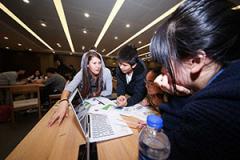Games Give Students a Look at Complexity of Real-World Decision Making

As the sun shines on the Suzhou Gaoxin District of China the air appears almost smoky.
Inside of 999 Taihu Avenue, the hazy smog isn’t lost on 30 ninth through twelfth grade students huddled in groups around computers. It’s the focus of an exercise to address air pollution challenges.
Led by Sarah Adair, senior policy associate at the Nicholas Institute for Environmental Policy Solutions, and several Duke University colleagues—Pratt School of Engineering Professor Marc Deshusses, post-doctoral student Jiele Xu and Duke Carbon Offsets Initiative Program Manager Charles Adair—the students are considering tradeoffs that electricity sector regulators face daily.
That is: how exactly do you weigh cost, environmental rules, and goals such as reliability or energy source diversity, to make investment decisions that reduce harmful air pollution such as smog, haze, mercury, and carbon dioxide?
It’s but one exercise in the three-day, hands-on DCOI Research Camp, sponsored by the Duke Carbon Offsets Initiative, that’s designed to build critical thinking skills and introduce the students to Duke’s interdisciplinary approach to climate and energy issues.
“One goal was to engage with these students on real-world air quality and environmental issues that are important to Chinese society right now,” said Sarah Adair.
Her exercise in assessment of energy portfolios was an abbreviated version of a “risk lab” the Nicholas Institute has conducted with the National Association of Regulatory Utility Commissioners to help American electricity sector stakeholders—from all sides of the table and across states—weigh their choices despite uncertainty about future environmental regulation, fuel prices, technology innovation, and a host of other factors in a changing electricity sector.
Just like the risk lab game is used to teach real-world concepts to electricity sector decision makers, the Carbon Offsets Initiative’s Charles Adair often leads Duke students and employees through a card game calling for them to decide where opportunities exist to make tradeoffs that could reduce emissions that help the university to meet its goal of carbon neutrality by 2024. At the research camp, students played this same game in which they learned where their own emissions come from using Duke’s Greenhouse Gas Inventory as an example.
Marc Deshusses helped the students relate advances in environmental technologies to their own lives.
“I talked about some of my research in the area of air pollution control using biological filters, the lack of proper sanitation in developing countries and managing fecal sludge with novel treatment methods, and our personal energy footprint,” Deshusses said.
What made this research camp so unique was its interactive, interdisciplinary teaching approach was something the students were not regularly exposed to in their Chinese classrooms.

“This research camp in China provided students with a great opportunity to learn basic concepts of sustainable development, carbon offsets, and environmental engineering in a way that was new to them,” said Xu, a post-doctoral who works with Deshusses and who helped to present the research camp. “Chinese students normally perform well on standard exams but usually lack training in developing research skills. This research camp provided an environment requiring more critical thinking, creativity, and team work and it gave them a chance to apply the knowledge they learned to real projects right away in the classroom.”
At the end of the three days, the students made it clear the camp had impact. As one student put it: we are going to be the decision makers in the future, so it’s important to pay attention to ensure you see the complexity as well as the possible approaches to the issues we’ll face.
--By Erin McKenzie
Photos by Zhaoqun Zou.
